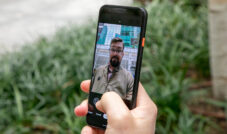
Quantum computing is the type of technology difficult to spring, with the potential to perform calculations in one step that would take a traditional computer hundreds of thousands of years to perform.
The problem is that the same escape of physics that gives the quantum calculation its incredible power makes it almost impossible to reliably control – but researchers say it can be about to change, and large-scale quantum fleas capable of Finally deliver the promise of quantum IT could be here much earlier than expected.
New research published in the progress of science The 13 have claimed that a new technique could give quantum computer engineers a way to control reliably, not only dozens or a few hundreds of qubit, but millions, by degrading One of the biggest obstacles that held quantum computer science to be commercially practical.
The problem with the qubits is that they rely on a phenomenon of quantum mechanics called overlay, which allows a subatomic particle to have two mutually exclusive properties (such as rotation of an electron) at the same time.
Quantum computer engineers use this superposition to represent those and zeros that constitute the basis of digital technology – the bit – but because of the overlay, a qubit can be both one and zero at the same time (so, in the Making a little quantum, or qubit for short).
This allows a quantum computer to perform complex unexpected calculations that would take an Intel Rocket Lake processor a billion years to perform at one time by calculating all the possible results simultaneously.
The problem is that the moment you “look” with a qubit, its superposition collapses in a defined state and simply becomes a uniform bit and the incredible computing power of the qubits is lost.
This makes it possible to effectively control the calculations to perform incredibly difficult calculations, which requires all kinds of equipment to block the external interference and to keep the quibs as close to the absolute zero as possible so that they remain mostly and do not come back Not all, all counts like “look” in terms of quantum mechanics.
This has Hamtrung engineers who have struggled to control dozens, hundreds, or at most a few thousand quits reliably, but now researchers with the University of New South Wales (UNSS), say that They solved the problem of Qubit control. Potentially unlock the power of quantum computing for our most pressing actual research issues such as medical research, climate forecast and much more.
“Up to this point, controlling which electron spin qubits rely on us with microwave magnetic fields by putting a current through a wire next to the keel,” said Jarryd Pla. , member of the faculty of electricity electricity and telecommunications school. “This poses real challenges if we want to increase the millions of quibits that a quantum computer will have to solve major problems, such as the design of new vaccines.”
The problem is that to add more than qubits, you must add more wires to generate the magnetic field needed to control them. The threads generate heat, however, and too much heat that can cause quibits to collapse into pieces, then throw more threads in a quantum processor simply do not work.
The researcher’s solution to this problem was to completely remove the wires and apply the magnetic control fields from above the quantum chip using a crystalline prism called dielectric resonator that allows you to control all the Qubits at the same time.
“We first deleted the thread next to the qubits, and then proposed a new way to provide microwave-frequency magnetic control fields all over the system,” said Dr. Pla. “So, in principle, we could deliver control fields up to four million qubits.”
Calculate a large quantum a reality
“I was completely breathtaking when [Dr. Dr. Pla] came to me with his new idea,” said Andrew Dzurak, an engineering colleague from Mr. Pla’s to UNSW who had spent years working on the implementation of quantum logic on silicon chips. “We immediately arrived at work to see how we could integrate it with the QUBIT tokens that my team has developed.”
“We were delighted when the experience was successful,” he added. “This problem of how to control millions of qubits worries me for a long time, because it was a major roadblock to build a large-scale quantum computer.”
Although this search may prove to be a critical step towards widespread quantum computing, on a large scale, much remains to be done. One of the challenges to overcome is that even if a quantum computer can calculate as many results as the number of quibs allows, reading the answer you want from these same quibits causes the same quantum deposit as heat or d Other interference. So, even if a quantum computer has calculated all the possible results, you can never access one of them at the end.
“The trick is to intelligently design your algorithm so that the right answer you are looking for is revealed at the end of the calculation, which always uses parallelism,” said Pla Techradar by email. “That’s why a quantum computer can only select tasks faster [than conventional computers] (such as factoring large composite first numbers, searching for non-trained databases, etc.) because it is Difficult to design such intelligent algorithms – however, people are improving so far etc. useful examples emerge almost every day. “
Other engineering challenges still need to be further addressed, such as refining error correction, so that not as many quibits needed to build quantum circuits.
“It is very important to note the difference between a” physical qubit “(that is to say in our case a single electronic spin) and a” logical qubit “”, told us Dr. Pla. “If all your physical qubits could be controlled and measured at infinite precision (no error error), you would have a quantum computer of 4 million Qubbit that could roughly solve any problem to which we could think right now.
“However, the qubits have errors and these errors are growing very quickly in a quantum circuit. You must therefore implement a form of error correction when they are encoded in groups of qubit (this is called error correction quantums). Quit quibrit groups protected by errors are called logical qubits. How many qubits you need in the groups depends a lot on the system, that is to say how much the qubits are connected and the rates of Real error.
“So, for example, we may need to need somewhere in the order of 1000 physical québits to produce a useful logic keel that can be used in calculations. This takes the number of 4 million accounts to 4000 – which is always very useful. At this level, you can break 2048-bit numbers encryption and simulate complicated chemical processes, elucidated protein structures, etc. “
Well, it’s a start, and we would not have the age of modern information without first producing the enciacy of the size of the room, but I hope we will not have much more Time to wait to see the potential of quantum computing comes to pass.






